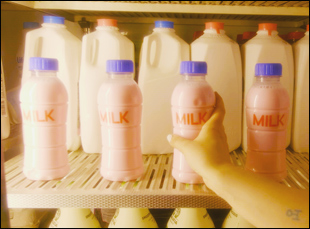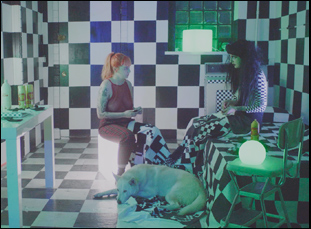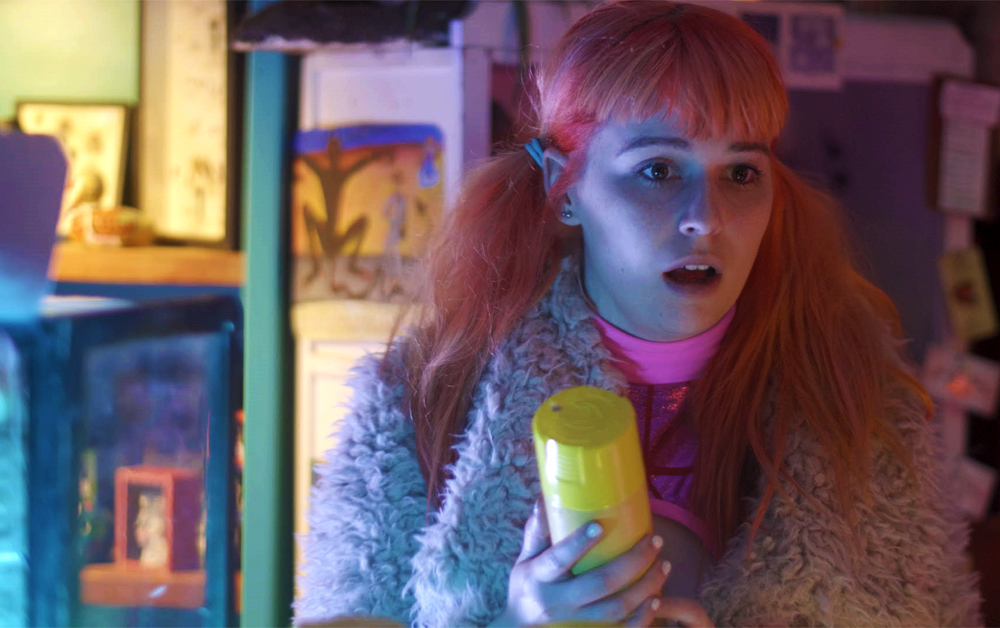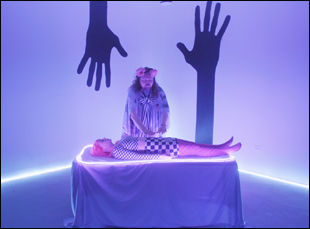Molly Hewitt had been watching “Long Island Medium” for fun when they stumbled into something of an epiphany. Skeptical of Theresa Caputo’s purported psychic abilities, Hewitt nonetheless was captivated by her skill at connecting with the living, if not the deceased.
“I watched the show a lot and it’s very formulaic, but she has this specific thing [where] she [talks] to everyone about God,” says Hewitt. “It really struck a chord with me because I felt regardless of the reality TV show structure and Catholic selling points, she really did tap into something [with the person she was speaking with], and maybe if she couldn’t speak to dead people, then maybe she’s incredibly sensitive and in tune with what people needed to hear.”
That notion becomes an incredibly intriguing jumping off point for Hewitt’s feature directorial debut “Holy Trinity,” in which the nonbinary performance artist reimagines their native Chicago awash in orange and pink with a company called Glambrand dominating market share by selling everything from cosmetics to cereal, monopolizing and homogenizing the culture. Everything is brighter and louder for Trinity (Hewitt), who takes a whiff of a new deodorant called Orishako Spray that heightens their senses to the point that they can start hearing voices of the dead, making their work as a dominatrix particularly awkward when their sessions start to include not only their clients but their loved ones who have passed. While this leads to any number of wild comic encounters, Hewitt centers the film with a genuinely moving consideration of how the panoply of voices begin to obscure their own judgment, pulling them away from hearing from those closest to them, whether it’s their lover Baby (Theo Germaine) or even their own inner voice.
In fact, the strongest voice that emerges in “Holy Trinity” is Hewitt’s with a refreshingly subversive and sex-positive adventure that boasts the kind of authenticity and originality that would seemingly make it immune from the the kind of co-opting by corporations that the filmmaker comes to question as Glambrand builds their marketing around empty LGBTQ sloganeering to line their pockets. Shortly before the film’s world premiere at Outfest Los Angeles, the director spoke about the inspirations behind their feature debut, drawing on the queer community of Chicago to make a film true to their experience and the spirit of collaboration that made the DIY film possible.
The story idea came about several years ago [when] I had seen these aerosol cans that they have in magic stores [that] have different scents or different intentions — you’re supposed to spray them in your house and they’re going to give you good luck or prosperity or money or devil be gone, and I had watched “Citizen Ruth” where [Laura Dern’s character] is huffing things constantly and the two and two clicked — I started with thinking about this character who huffs an aerosol can and then develops the ability to speak to the dead. [laughs] Initially, it started as a much more basic [question of] “What is real? Is God real?” I had been piecing together my own spiritual beliefs, coming from a Catholic high school background and then [I was] meeting a lot of people in Chicago who are practicing lots of different religions and spiritualities and as I got into BDSM and started having lots of different kinds of experiences, [where I] started comparing the juxtaposition between what I was taught in Catholic school and what I was experiencing in real life, [the story] evolved.
Were you pulling ideas from your other projects through the years or was this a wholly new endeavor? I know the idea of the Glam world the character lives in is something you’ve cultivated and there’s an entire product line in the film.
This did feel like a new endeavor, but aesthetically, it definitely fits into what I’ve been doing before. I wanted to tighten the screws a little bit and make something a bit more polished. Glam Hag is my performance name and alter ego and I thought it would be interesting if that was also the name of all of the products and it’s not really ever talked about, but it’s lingering throughout everything and slowly taking over the world they live in. I definitely have my production designer to thank for [putting together the product line]. Their name is Mood Killer and they’re probably the only person that I trust to do something which aesthetically lines up with what I wanted. They, along with a team of PAs and volunteers, just collected a lot of trash and then we spent a lot of time spray-painting. The whole thing was very DIY-spirited, but it did take a lot of work.

Yeah, it’s like Chicago in an alternate universe where it’s a little bit more colorful and strange. The times when we didn’t do our own production design from the ground up, we chose spaces that already fit the loud level that we were aiming for, or specifically if they were going to walk past a building, I just made sure to choose a building that fit in with that and was equally colorful. There’s definitely a lot of sites around Chicago that fit into the aesthetic. It was mostly filmed on the South Side.
One of my favorite things about the film was the checkerboard theme throughout, which you do find on the side of a building as well as make it part of the interiors. I wouldn’t want to spoil its eventual meaning, but where did you get the initial idea?
Yeah, what’s really great about that is I feel like I got so into that checkerboard aesthetic from Heather Lynn, the actor who plays Carol and they tiled their entire studio gallery space from old checkerboard. They just had the impulse to do it, but once they looked into it more, it’s really a traditionally spiritual pattern. You see it a lot in sacred geometry and freemasonry spaces and it’s a kabbalah symbol of duality, which I was definitely thinking about a lot in the film – dark and light, good and bad. I definitely became obsessed with that pattern, and it started with Carol’s character and the actor also helped me writing a lot of that dialogue as well, so I tried to have it in the scenes as many times throughout whether it was with costumes or set-pieces.
Did you already have a lot of people in mind while writing the script for this?
Yeah, the script was loose in some areas that allowed for the characters to change depending on who was going to play the roles, but then pretty much everyone except for Baby was an exaggerated version of who is playing the role, so they’re all non-actors that are just my friends in Chicago. Everybody does performance, so they weren’t completely new to acting, but I definitely collaborated with all of the performers to write their own dialogue. If there was something where somebody was like, “I would never say that,” then we wouldn’t have them say it. Everything was really flexible, depending on how people wanted to be represented.

Yeah, it was a wild day. [laughs] It was all shot during the day, which is funny, and we actually filmed that part about a year before we shot the rest of the film and used that as a proof of concept to get people interested in doing our Kickstarter. Because it is the most spectacular scene, I wanted to do that to show how good we could make things look and everyone did their own costumes. I just thought it was cool to invite my friends and members of the queer/drag performance community that I know. Joe [Swanberg, an executive producer on the film] actually came to the set — I met him that summer, and we had a performance, a little show the day after we shot the [party] scene, and he came to check it out. A little down the line, [his company Forager Films] decided to join on as a production company.
After working in other artistic mediums, was a full-length feature any different?
It was a really different process than if I had not been in front of the camera. I was preoccupied so much of the time and it led to this really interesting melding of brains between me and Judy [Febles], my first AD and Mood Killer, my production designer and Greg [Stephen Reigh], my DP. I trusted them all to know what I wanted and there were a lot of times when the three of them had to direct instead of me because I just didn’t have the capacity at those moments, so it really felt like a cool collaboration in that way. But it just felt like a whirlwind and then suddenly, it was finished. It’s definitely so different from other things that I’ve worked on in the sense that it takes so long, so it’s not something you’ve just worked on for a month or a week. It’s like a several year process, so especially the scenes that we shot two years ago, it’s interesting to include that and I really am just excited and ready to enjoy this part of it and see people’s reactions to it.
“Holy Trinity” will play at Outfest Los Angeles on July 19th at 9:30 pm at the MOCA Grand.





